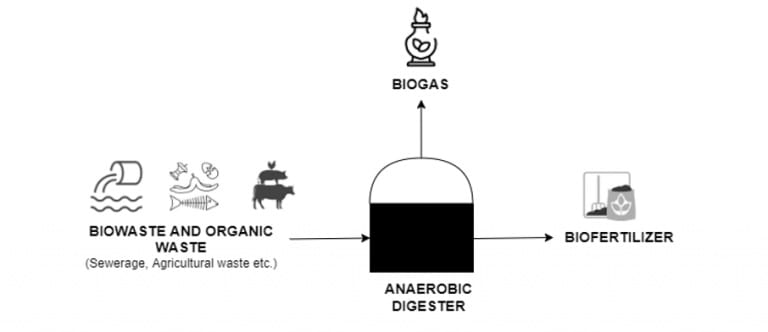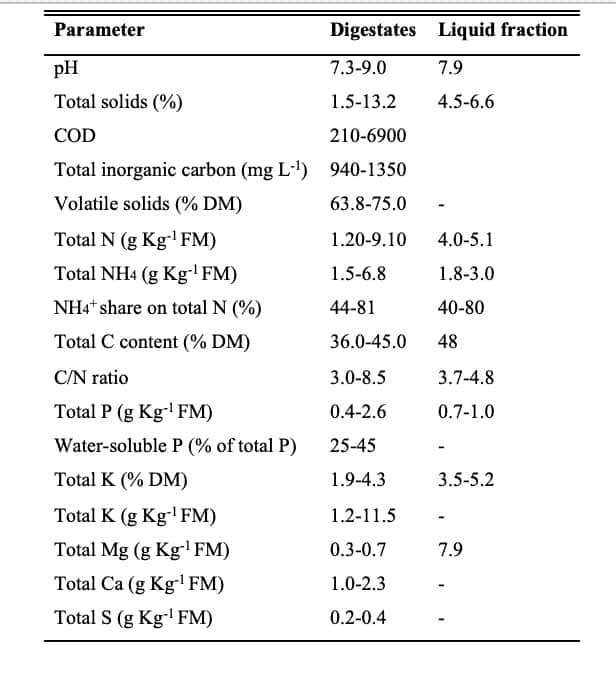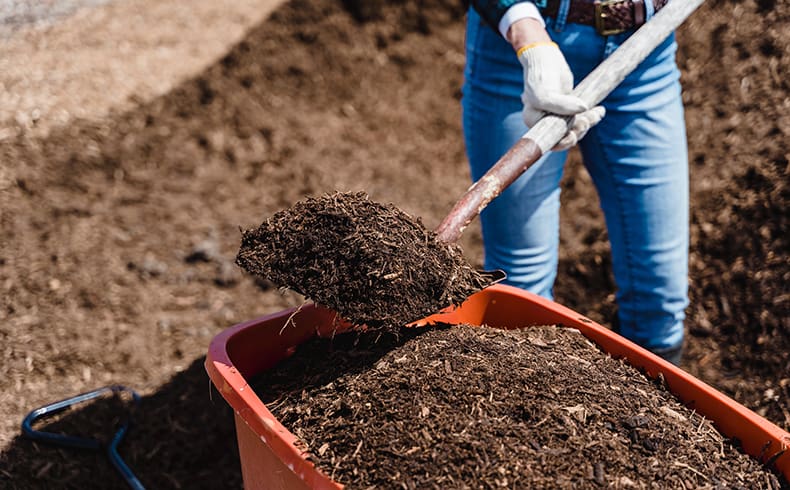The Environmental Protection Agency (EPA) recently published Research 375: Development of Quality Standards for Compost and Digestate in Ireland in May. This study developed a quality standard for digestate and an updated standard for compost, and recommends a strategy on how Ireland should implement national end-of-waste criteria for compost and digestate, since there are no national end-of-waste criteria for compost and digestate derived from source separated materials in Ireland.
Moreover, recent European Union (EU) circular economy and bioeconomy policies and the New European Green Deal promote the recycling of nutrients from organic wastes into products that can be used as soil improvers and fertilizers, created a renewed interest in the use of compost and digestate.
But what is digestate and why it is becoming a trending topic in Ireland?
Due to the increased prices of petrochemical fuels, and the simultaneous impact of fossil fuels on greenhouse gas emissions contributing to global warming, the world is searching for alternative renewable energy sources. Renewable energy is derived from natural sources and are replenished at a higher rate than they are consumed at, and includes sources such as solar, wind, hydro, geothermal and biomass. Research has shown that biomass energy has the highest capability amongst other renewable sources.
Anaerobic digestion is the most traditional method used to generate energy from renewable biomass sources. It was originally highlighted by Alessandro Volta in 1776 and has grown immensely since the 1970s. Anaerobic digestion is a collection of processes by which microorganisms break down biodegradable material in the absence of oxygen. The process is used for industrial or domestic purposes to manage waste and/or to produce fuels. The process produces biogas (consisting of methane, carbon dioxide, and traces of other gases), where the biogas can be used directly as fuel, and/or in combined heat and power gas engines. It has many advantages compared to other processes such as re-use of waste as a resource, producing carbon-free biofuel and replacing fossil fuels and eliminating the energy footprint of waste treatment plants.
Last but not least, there is one more benefit of anaerobic digestion processes – the digestate. Digestate is a by-product of anaerobic digestion processes, and is a nutrient-rich substance that can be used as a fertiliser. It consists of left over indigestible material and dead micro-organisms that is 90% liquid (liquid digestate) and 10% solid (solid digestate). The solid digestate can be employed similarly to compost or can potentially be composted with other organic residues, which can be more economically conveyed over larger distances than liquid material. This separation allows for the treatment or valorization of each fraction by mechanical, physicochemical or biological means.

As an increasingly favourable alternative to slurry spreading, digestate spreading has proven itself to be a great organic fertiliser that offers valuable nutrients that can vastly improve soil quality resulting in a potentially increased output of healthier crops. The practice of land application of digestate can improve the health of the soil by increasing organic matter content, reducing the need to apply chemical fertilizers and pesticides (where chemical fertilizer causes an increase in pests and kills the beneficial microbes present in the soil), improving plant growth, reducing soil erosion and nutrient runoff, alleviating soil compaction, and helping increase the soil’s water holding ability, which reduces the need for irrigation. Analysis shows that an impressive 80% of the total nitrogen in food-based digestate is present as readily available nitrogen. This high level of availability means that digestate can be used as a direct replacement for ‘bagged’ nitrogen fertiliser. Digestion of livestock slurry will typically increase availability of the nitrogen in the slurry by around 10%. Moreover, digestate contains useful amounts of phosphate and potash, together with small quantities of other nutrients and trace elements to help maintain soil fertility, which makes digestate an amazing alternative to chemical fertilizers.
If digestate is directly discharged to water, it may cause eutrophication (ie harmful algal blooms, dead zones, and fish kills) due to its high nutrient content, and may cause other issues such as odour emission, toxic organic compounds, pathogens and phytotoxicity (ie adverse effects on plant growth, physiology, or metabolism) if directly used on soil; therefore, a quality standard for digestate is a necessity.
When anaerobic digestates are added into soils, different nitrogen forms are either absorbed by plant root cells, or adsorbed onto negatively charged soil particles, or oxidized by microorganisms. Best management practices that can be employed to alleviate nutrient leaching includes: alteration of digestate nutrient supply to crop demand and soil tests, synchronization of nutrient release with crop developmental demand, cultivation against slopes, avoidance of fall applications, lengthly period gaps between digestate employment and sowing, and applications that undertaken before heavy rains.
The microbiological status of the output digestate is dependant on the quality of the input biomass and on the configuration characteristics of the digester such as pre-treatment (pasteurisation), digestion temperature, pH, nitrogen concentration. The tenacity of various pathogens in digestates can be explained by the presence of bacteria species possessing the ability to form protective coatings (spores). These spore-formers are not eradicated during the anaerobic digestion process and regrowth of pathogens and their spores is possible in storage facilities. Stabilization of digestates through post-treatment measures such as curing and composting substantially decreases the risk they pose to human health and the environment. Typical nitrogen and phosphorus concentrations range between 5 and 15 kg N/ ton and 0.1 and 1 kg P/ ton respectively in cattle and chicken manure. These nutrients remain in the digestate after anaerobic digestion and, following an adequate treatment, can be recovered in a concentrated form of which can be easily transported.
The composition of digestates differs extensively with regards to the feedstock, inoculum source, and operating conditions of AD (e.g., temperature, pH, hydraulic retention time). It can be abundant in a number of macro nutrients (e.g. N, P, K, S, Mg, Ca, Fe, and Na) and may also comprise of a number of trace elements (e.g. Co, Fe, Se, Mo and Ni) either as a result of the initial biomass used or becaue of supplementation, addition of trace elements for enhanced digester performance. The great amounts of potentially toxic effluents, due to the presence of non-biodegradable compounds such as recalcitrant organic molecules, high ammonia concentration, and heavy metals that become available, together with the rising storage and transportation expenses, lead to the requirement of implementation of appropriate management practices. Generally, the initial step of each digestate treatment procedure involves the physical solid–liquid separation. Normally, 40 to 86% of the organic matter is present in the solid fraction, while the liquid phase is comprised of a low organic matter content. The solid fraction contains approximately 75% of phosphorus, which is directly absorbed or trapped with calcium, magnesium, and nitrogen. The digestate liquid is categorized by low organic matter and phosphorus concentrations, counterbalanced by increased potassium and nitrogen concentrations (up to 80% in the form of ammonium). Typically, the resulting solid manure high in dry matter (DM) and the liquid manure low in DM obtained is directly employed as fertilizer (Table 1).

In conclusion, there is a wide range of anaerobic digestates whose composition and nutrient content depend upon the nature of the source of the biomass (such as cattle manure, livestock manure, agricultural residues, organic solid wastes, sewage sludges, dairy manure, food wastes, and landscape wastes) and the digestion process. The digestate, which is plentiful in valuable nutrients, can therefore be directly employed as a renewable fertilizer due to its contents of stable organic carbon and nutrients. Cosidering current inceasing costs for fertiliser products, AD is an exciting technology to addres this need, along with enery production and waste utilisation. When an excess of nutrients occurs in a given region, the digestate can be further treated to recover nutrients in concentrated forms, allowing them to be translocated at sustainable prices in various agricultural areas. However, a key environmental concern with land application of digestates is the potential contamination of surface and ground waters, alongside the eutrophication of water bodies with abundant volumes of nitrogen and phosphorus. Therefore, it is essential for Ireland to have an informed policy and develop solutions for digestate in future. For more details, please see “Research 375: Development of Quality Standards for Compost and Digestate”.
Development of Quality Standards for Compost and Digestate report: https://www.epa.ie/publications/research/waste/Research_Report_375.pdf
